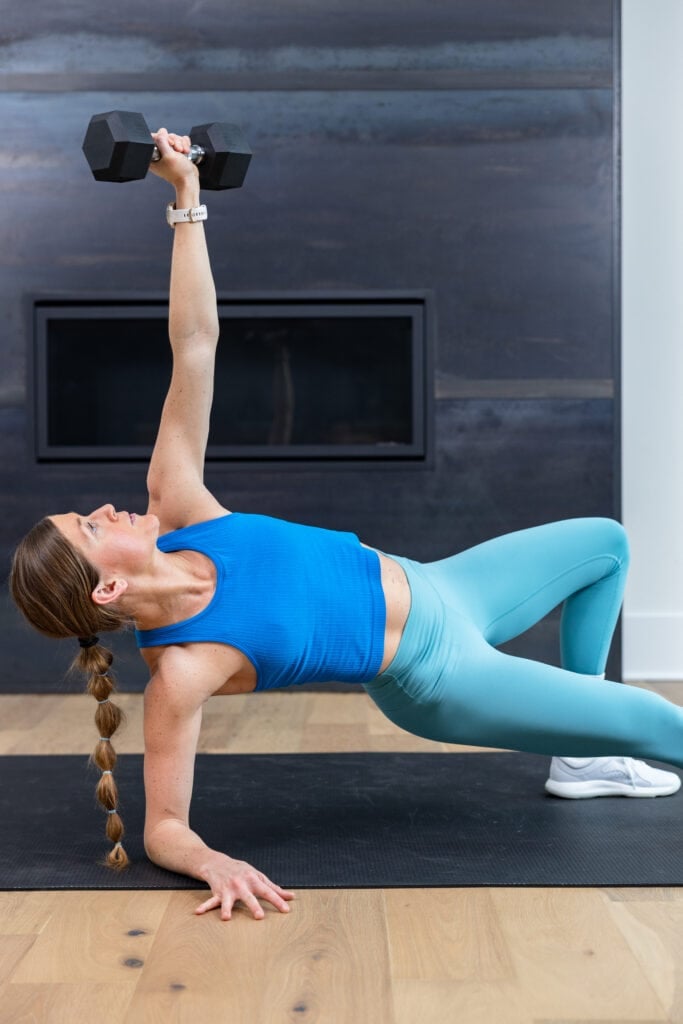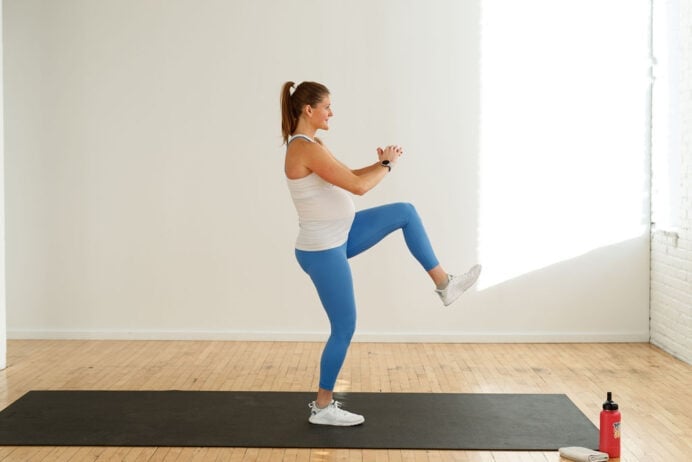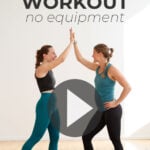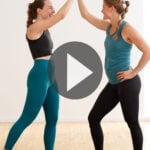

15-Minute Partner Workout At Home (No Equipment + No Repeats)
Buddy up for these 15 partner exercises you can do with a friend; no equipment needed! A FUN, total body workout that includes partner planks, push ups, squats, lunges and more. Grab your best friend, workout buddy or significant other and knock out these partner exercises for a quick, 15-minute bodyweight workout.
Grab a friend and challenge your total body strength with this 15-minute partner workout.
On days I need some extra motivation to get moving, I grab my husband or a friend to join me. There are so many benefits to a partner workout:
- Improves Accountability. It’s a lot easier to oversleep and miss your workout, or skip the final few reps of an exercise when you’re doing it alone. Adding a partner increases accountability (and if you’re like us, adds a little competition — making you both work harder).
- Quality Time with Your Partner. Let’s be honest — we’re all busy, especially if you and your partner are also wrangling kids. A partner workout is a great way to spend quality time with your partner AND knock your workout out — two for one!
- Makes Workouts More Fun! It’s important to remember that the reason we workout is because it makes us feel good. Adding some fun back into your workouts is a great way to mix up your routine, especially if you’re starting to feel burnt out.
This total body workout requires no equipment. Just you, your buddy and 15 minutes of time.
These 15 partner exercises are the perfect way to get your friends and family moving over the holidays or on family vacation (when you don’t have access to a full gym).

Partner Workout FAQs
A partner exercise is one that can be done with another person. The partner or workout buddy may provide support or an added challenge to an exercise. Today’s workout includes 15 bodyweight partner exercises. See the photo above for a great example of a partner exercise. Partner A (Rachel) is doing a wall sit. While Partner B (Lindsey) is performing tricep dips on Rachel’s bent legs.
You can do a variety of exercises with a workout partner. Variations of partner planks, push ups, squats, and lunges are great examples of exercises you can do with a workout buddy.
Partner workouts have a ton of benefits. They improve accountability, allow for quality time with your partner, and are a fun option to mix into your workout routine to avoid burn out or boredom. This couples workout is a good mix of challenging and fun exercises.

15-Minute Partner Workout At Home
Grab your workout buddy or significant other and knock out this fun partner workout!
Upper body, lower body, cardio and core — this couple workout hits it all in 15 minutes.
Work through 15 partner exercises using just your body weight. A great way to spend time with your partner while also burning calories, building muscle and reaching your fitness goals.
You can do this no equipment partner workout at home or take it outside and make it an outdoor partner workout. A great way to maintain a fitness program over the holidays and while traveling on vacation.
Workout Equipment:
No equipment, just your bodyweight.
Shop My Extra-Large Yoga Mat
DISCOUNT CODE: NourishMoveLove

Workout Instructions:
Follow along with the guided Partner Workout on YouTube, led by certified personal trainer, Lindsey Bomgren.
Your Workout Looks Like This:
- 15 Bodyweight Partner Exercises (10 exercises total, but 15 moves when you switch left/right sides of the body)
- Timed Intervals (40 seconds work, 20 seconds rest)
- No Repeats
Workout Outline
- Plank Walk Out and 2 Partner High Fives
- Push Up and Partner Hand Press
- Squat and Partner Rotations
- Pendulum Lunge, R
- Lunge Hold and Chop, R
- Pendulum Lunge, L
- Lunge Hold and Chop, L
- Low Plank Hold and Partner Hop Overs
- Wall Sit and Partner Tricep Dip
- Low Plank Hold and Partner Hop Overs, Switch Roles
- Wall Sit and Partner Tricep Dip, Switch Roles
- Side Plank Crunch and Partner Foot Tap, R
- Heels Together Glute Bridge
- Side Plank Crunch and Partner Foot Tap, L
- Feet Together Bicycle Crunches

Prefer to Watch On YouTube?
10 Partner Exercises At Home
Plank Walk Out and 2 Partner High Fives
Targets: Legs, glutes, quads, hamstrings, hips, low back, shoulders, arms and core.

How To Do A Plank Walk Out and 2 Partner High Fives
- Start by standing directly across from your partner, facing each other with your feet hip-width apart; arms straight overhead.
- Hinge forward, bending your knees and reaching your hands towards the mat. Once your hands find the mat, walk out to a high plank position.
- Hold high plank about 6 inches apart from your partner; palms flat on the mat, shoulders stacked over wrists, core engaged, creating a straight line from your head to your heels.
- Lift your right hand off the mat to give your partner a high five. Place your right hand back on the mat, then raise your left hand from the mat to clap your partner’s hand again. All while holding a high plank position.
- With both hands planted back on the mat, walk your hands back to meet your feet and stand tall, reaching your arms straight overhead.
Modification: Option to drop to a kneeling plank position for the partner high fives.
Push Up and Partner Hand Press
Targets: Chest, shoulders, triceps, back, abs and core muscles.

How To Do A Push Up and Partner Hand Press
- Start in a high plank position facing your partner (about 1 foot apart) with your shoulders stacked over your wrists, weight evenly distributed amongst all 10 fingers. Pull your kneecaps up towards your belly, feet hip-width apart.
- Hold this push-up position, maintaining a straight line with your body, gaze slightly in front of you.
- Perform one push up by lowering your chest down towards the ground as your elbows fall back towards your hips.
- Exhale as you push back up into high plank position.
- Hold high plank and reach your right hand out directly in front of you to meet your partner’s left hand. Push into each other’s hands for a second, creating tension. The harder you press into your partners hand the harder this exercise will be.
- Re-plant your hands on the mat and perform another push up.
Modification: Option to drop to the knees for a kneeling push up and plank.
Squat and Partner Rotations
Targets: Legs, glutes, quads, hamstrings, hips, spine, back and core.

How To Do A Squat and Partner Rotations
- Start by standing directly across from your partner (about 2 feet apart), feet shoulder-width distance apart, knees slightly bent.
- You and your partner should both reach your right arms out long and grab onto each other’s right hands/forearms. As you do so, rotate your torso to the left.
- While holding hands, lower down into a squat position, lowering your hips down parallel with your knees. Drive your knees out toward your outer three toes.
- Drive through your heels to stand tall and return to a standing position. Rotate your torso back to center.
- Drop your partner’s right hand and extend your left arm long to grab your partner’s left hand.
- Repeat this sequence, alternating the arm that reaches out to grab your partner between each squat.
Pendulum Lunge
Targets: Legs, butt, quads, hamstrings, calves and core.

How To Do A Pendulum Lunge
- Start by standing directly across from your partner (about 1-2 feet apart), feet hip-distance apart.
- Step your right leg forward into a front lunge, dropping your back left knee down towards the ground as you lower your hips until both knees reach a 90-degree angle, front thigh is parallel to the floor.
- As you do so, your partner will step their left leg back into a reverse lunge, dropping their left knee down towards the ground.
- Reverse these movements to return back to a standing position.
- Rather than stopping at the top, immediately step your right leg into a reverse lunge. As you do so, your partner will step their left leg into a front lunge.
- Repeat this back and forth movement (pendulum lunge), one of you stepping into a front lunge while the other steps into a reverse lunge. You’ll switch legs on the next set.
Lunge Hold and Chop
Targets: Legs, quads, hamstrings, butt, calves, obliques and core.
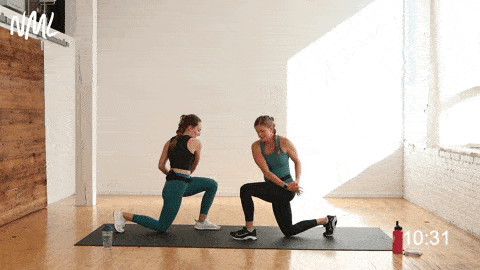
How To Do A Lunge Hold and Chop
- Start by standing directly across from your partner (1-2 feet apart), feet hip-distance apart.
- You and your partner will each step your right leg back into a reverse lunge, dropping your right knee down towards the ground as you lower your hips until both knees reach a 90-degree angle, front thigh is parallel to the floor.
- As you hold this split lunge stance, fold your hands together and bring both hands to your left hip.
- Then squeeze your left glute, keeping the weight in your front (left) heel as you stand tall, returning to the top of your split lunge.
- As you stand tall, twist through your torso/core to chop your hands toward your midline; meeting your partner’s hands in the center.
- Lower back to the bottom of your split lunge; clasped hands return to left hip.
- Continue this lower, lift and chop movement. Then switch sides (left leg back, chopping to the right) for the second set.
Low Plank Hold and Partner Hop Overs
Targets: Full body — arms, abs, legs and core as you hold the low forearm plank. And legs, hips, hip flexors, calves and core on the partner hop overs.

How To Do A Low Plank Hold and Partner Hop Over
- One partner will start in a low plank position, forearms on the mat with shoulders stacked over elbows, arms shoulder-width apart, straight line through the spine.
- The other partner will stand directly over the partner; straddling their partner as they hold a low plank.
- The standing partner should begin in an athletic stance, knees bent, ready to move side-to-side.
- Next, the standing partner will perform a double hop on the right leg, driving the left knee up in line with the left hip.
- Then, the standing partner will shift their weight to double hop on the left leg, driving the right knee up in line with the right hip.
- The standing partner will continue to alternate this side-to-side high knee hopping pattern while the partner on the ground continues to hold a low plank position.
- Switch roles on the next set.
Modification: Option to perform standing knee drives instead of hop overs.
Wall Sit and Partner Tricep Dips
Targets: Legs, glutes, quads, hamstrings and core as you hold the wall sit. And triceps (back of your arm), chest, traps, shoulders and core on the tricep dips.

How To Do A Wall Sit and Partner Tricep Dips
- One partner will start holding a wall sit; back flat against the wall, knees bent at a 90-degree angle, thighs parallel to the floor.
- The other partner will perform tricep dips on their partner’s bent legs. To perform tricep dips, grip the knees of the partner performing a wall sit, fingertips pointed toward your butt or toes, elbows bent.
- With each tricep dip think about keeping your back close to their partners legs, bending just at the elbows until elbows reach a 90-degree angle.
- Then press through the palms, using the triceps (back of the arm) to push back up to starting position.
- The partner performing a wall sit will maintain the wall sit.
- Switch roles on the next set.
Side Plank Crunch and Partner Foot Tap
Targets: Internal and external oblique muscles (the muscles that run along the side of your core), outer glutes, abductors, hips and hip flexors.
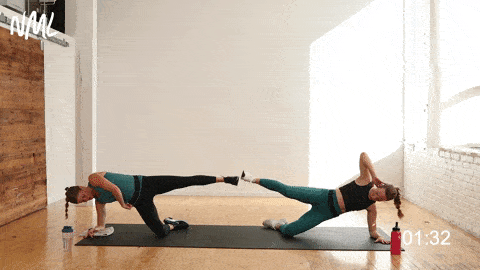
How To Do A Side Plank Crunch and Partner Foot Tap
- Each partner starts in a modified side plank position, or knee down side plank position. With one knee bent at 90 degrees on the mat and other leg extended long. And one forearm on the mat, shoulder stacked over elbow.
- Perform a side plank crunch by pulling the floating leg towards your elbow. Think knee to elbow; arm and leg meet as you squeeze your obliques (side abs).
- Then as you kick your floating leg long back into a modified side plank reach the sole of your foot out to tap or touch the sole of your partner’s foot.
- Repeat this side oblique crunch and partner heel tap. Then switch sides, for the second set.
Heels Together Glute Bridges
Targets: Legs, glutes, hamstrings, hips, low back and core.

How To Do Partner Glute Bridges
- Each partner will lie flat on the floor on their back, knees bent at a 90-degree angle and heels together (butts about 2 feet apart), arms extended at their sides.
- From this position both partners will push their feet into their partner’s feet.
- As you press into each other’s heels, lift your hips off the ground until your knees, hips and shoulders form a fairly straight line (performing a glute bridg). Squeeze those glutes hard and keep your abs drawn in so you don’t overextend your back during the exercise.
- Hold the bridged position for a couple of seconds before easing back down with control.
Feet Together Bicycle Crunches
Targets: Abs and core, with an emphasis on the lower abs, obliques and hips.
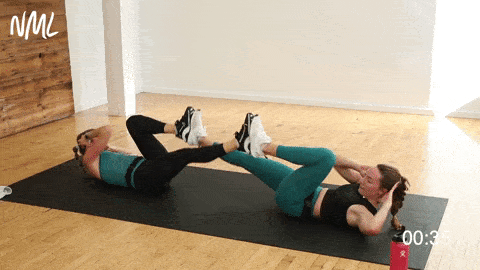
How To Do Bicycle Crunches with a Partner
- Each partner will lie on their back, knees bent at a 90-degree angle, soles of the feet pressing together (butts about 3 feet apart).
- Press the low back into the mat to ensure the deep core is engaged and place the hands behind the head.
- Engage the upper abs to lift the neck and shoulders off the ground. Focus on pressing the head into the hands rather than pulling on the neck.
- From here, alternate kicking out each foot, extending one leg out while the other knee bends towards the chest; mimicking a ‘bicycle’ pattern.
More Workouts
Bodyweight WorkoutsPin this Workout: 15-Minute Partner or Couple Workout At Home

This post includes affiliate links. I do make a small commission for products purchased using these links (at no additional cost to you). Thank you for supporting Nourish Move Love, making the content you see on this blog possible.










